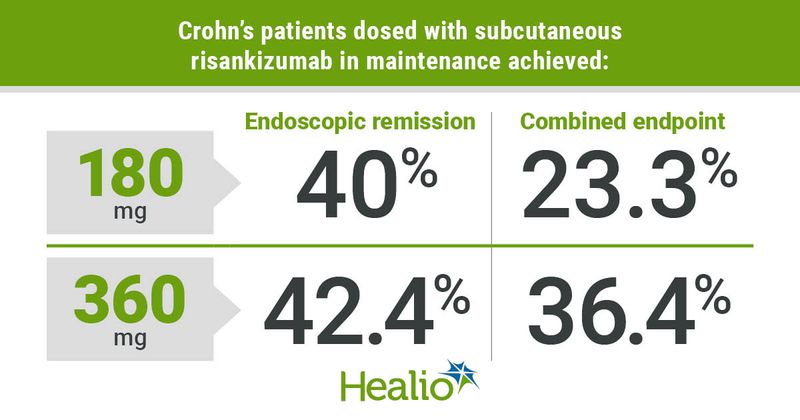Subcutaneous Skyrizi beneficial in delayed, non-responders to IV induction therapy for CD
CHARLOTTE, N.C. — Subcutaneous risankizumab as maintenance therapy was efficacious and well-tolerated in patients with Crohn’s disease who had a delayed response to induction, according to research at the ACG Annual Scientific Meeting.
Previous results from the ADVANCE and MOTIVATE phase 3 induction studies determined IV risankizumab (Skyrizi, AbbVie) bested placebo in achieving clinical and endoscopic improvement at week 12 among patients with moderate to severe CD, Marla Dubinsky, MD, professor of pediatrics and gastroenterology at the Icahn School of Medicine at Mount Sinai, reported.

Patients who did not achieve a clinical response at week 12 (induction dosing, 600 mg or 1,200 mg) but who did achieve response at week 24 following additional subcutaneous dosing were included in the FORTIFY study and received subcutaneous risankizumab 180 mg (n = 30) or 360 mg (n = 33).
Researchers defined clinical response as a greater than 30% decrease in average daily stool frequency and/or a greater than 30% decrease in average daily abdominal pain score (both not worse than baseline of induction).
At week 52, most delayed responders on risankizumab 180 mg and 360 mg achieved clinical response and remission, including reduction of Crohn’s Disease Activity Index by at least 100 points from baseline and at least 60% decrease in average daily stool frequency and/or at least 35% decrease in average daily abdominal pain score.
Further, patients in both groups also achieved endoscopic response (36.7% and 45.5%, respectively), endoscopic remission (40% and 42.4%), deep remission (40% and 39.4%), ulcer-free endoscopy (27.6% and 24.2%) and the combined endpoint of stool frequency/abdominal pain score clinical remission and endoscopic response (23.3% and 36.4%).
Dubinsky and colleagues also observed a dose-response trend, in which higher response rates were achieved in most outcomes among those on risankizumab 360 mg vs. 180 mg.
Maintenance dosing was well-tolerated with consistent treatment-emergent adverse events as previously reported.
“Subcutaneous risankizumab was efficacious and well-tolerated in patients with delayed clinical response to induction,” Dubinsky said. “These findings underscore the additional benefit of initiating dosing of after IV induction.”

